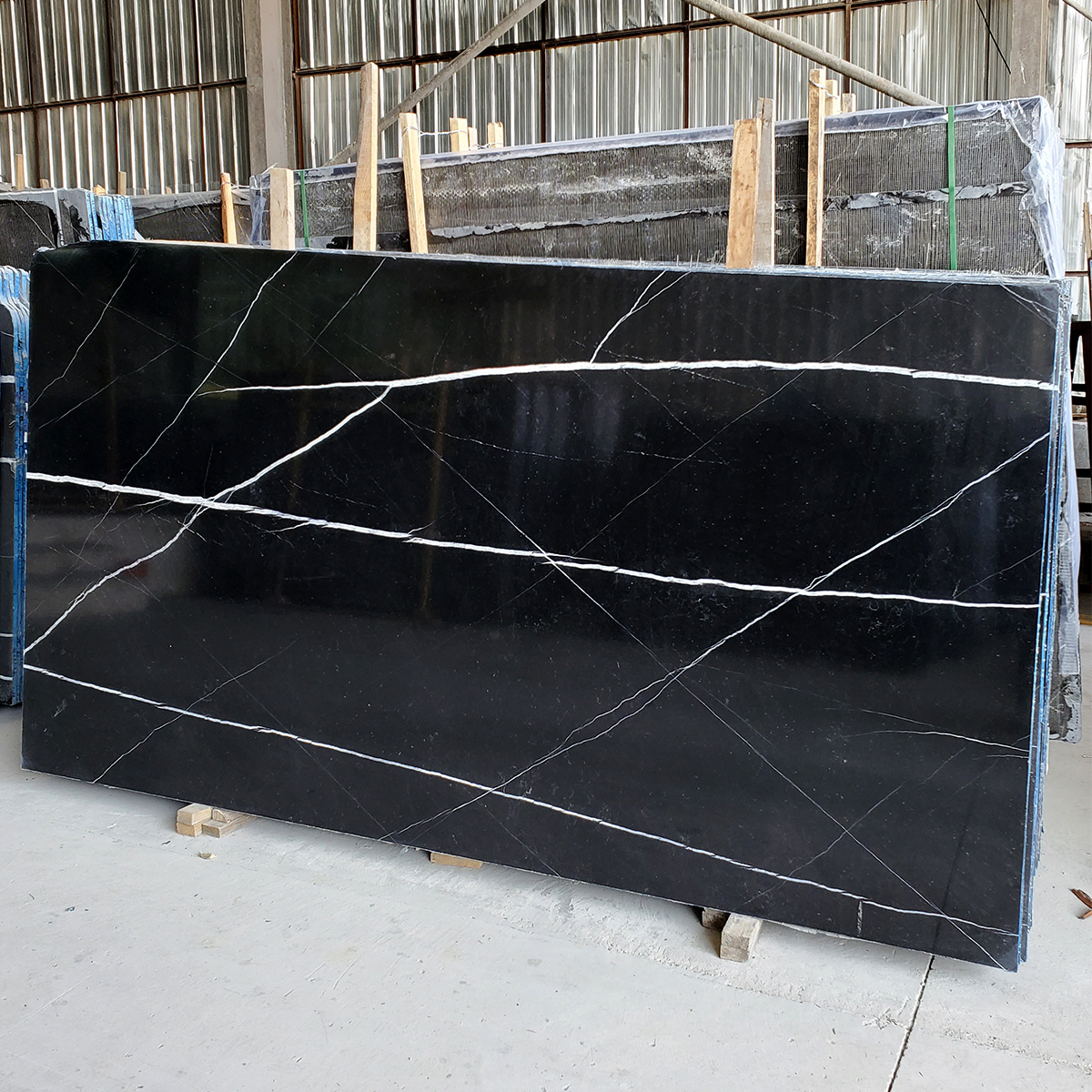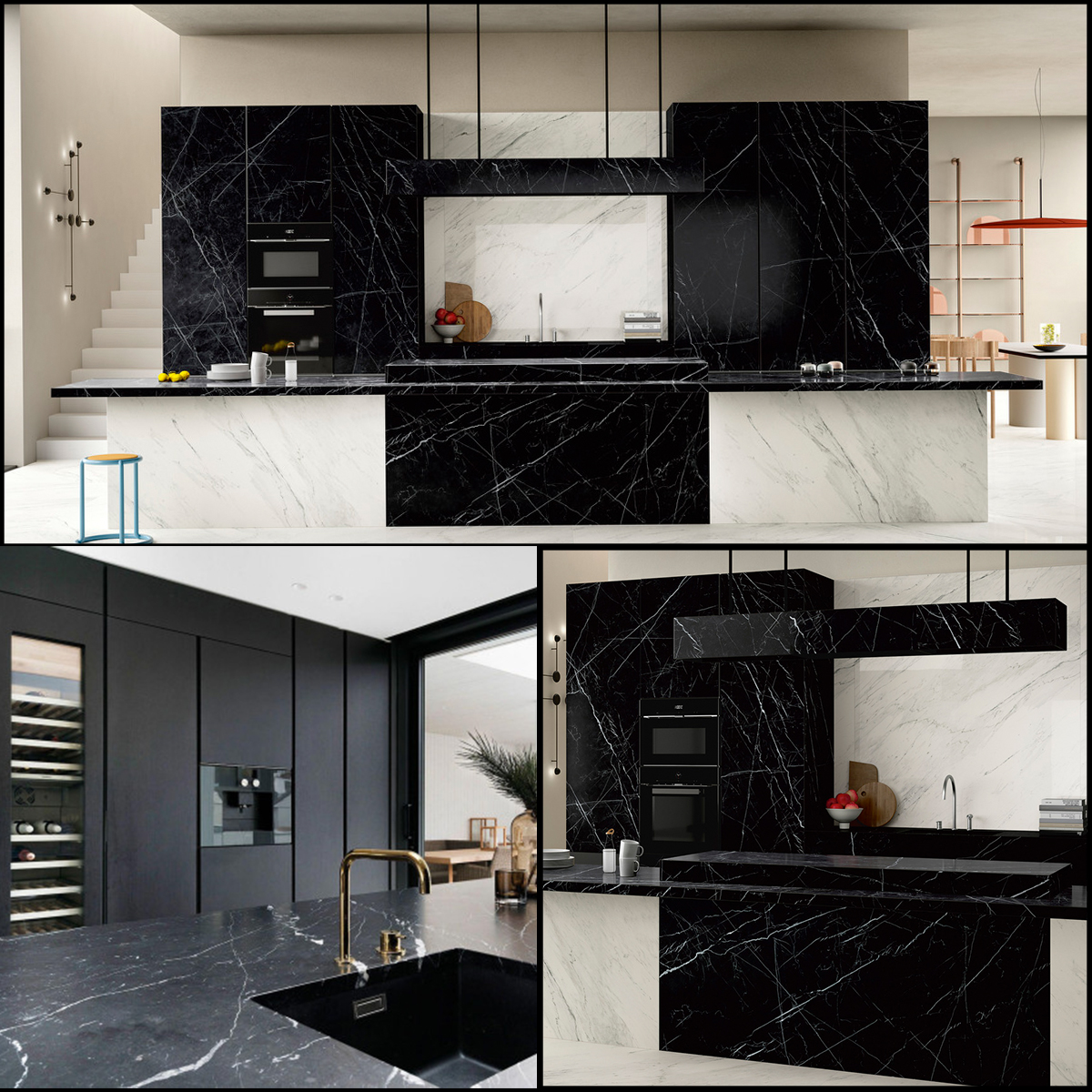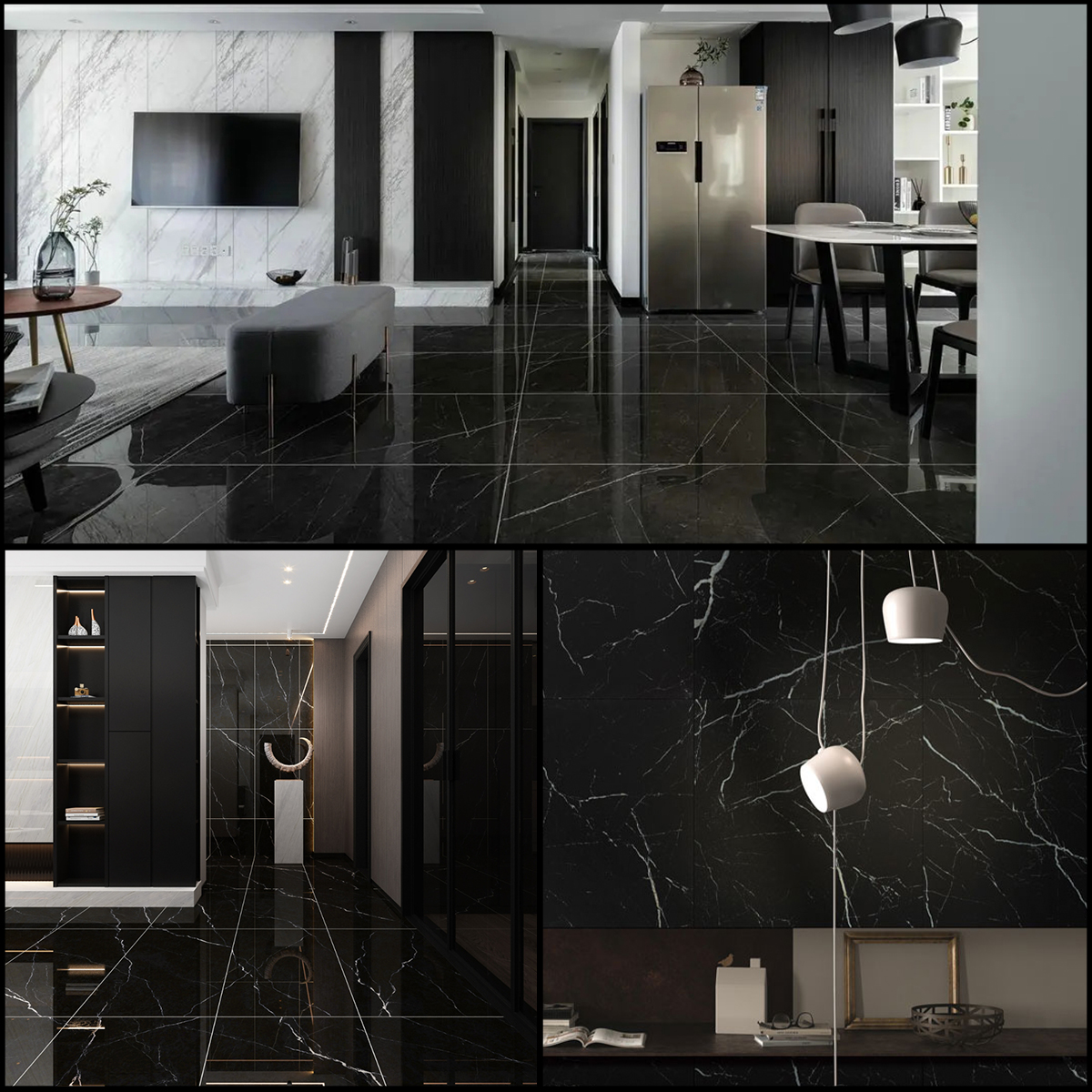Black Marquina marble, internationally known as Nero Marquina, is one of the most distinctive black stones in contemporary design, combining a deep ink‑black background with sharp white veining that reads like light passing through a night sky. In modern interiors it anchors spaces with visual weight and precision, yet remains versatile enough to move seamlessly from gallery‑calm minimalism to richly layered luxury environments.
For Future Stone Group’s core audience of architects, interior designers, contractors, and discerning homeowners, Black Marquina offers not only dramatic aesthetics but also measurable performance, predictable fabrication behavior, and strong market recognition in both developed and emerging markets. Its proven track record in high‑end villas, hotels, retail, and marble furniture makes it a strategic material choice wherever a project must project confidence and long‑term value.
Origin and geological profile
Black Marquina is quarried in the Markina area of the Basque Country in northern Spain, where compact black limestone layers have been metamorphosed into a fine‑grained marble rich in calcite. Geologically it is a dense, homogeneous stone cut through by calcite veins and local fossil inclusions, which translate visually into its characteristic bright white streaks on a black ground.

Petrographic and laboratory testing place its apparent density around 2680–2700 kg/m³, with very low open porosity (approximately 0.1–0.2%), confirming its suitability for interior flooring and cladding under standard design loads. This combination of compact structure and low water absorption underpins its durability in interior use, provided that the stone is detailed and maintained in line with best practices for calcitic marble.
Visual identity and design impact
Visually, Black Marquina is defined by an intense black field intersected by irregular white veins that may appear as hairline threads, fragmented lightning bolts, or broader ribbons depending on block and cut. The fine grain amplifies polish, so the surface can achieve a mirror‑like effect that deepens the black tone and makes the veining appear almost luminous under controlled lighting.
This strong graphic identity has made Black Marquina a staple in contemporary feature walls, fireplace surrounds, and sculptural tables, where designers leverage its contrast to create a single dominant gesture rather than a busy pattern. Used judiciously against quieter materials, it brings a sense of precision and tailored luxury that aligns closely with premium residential and hospitality branding.
Technical performance and standards
Independent test data for Nero Marquina show flexural strength typically in the 13–15 MPa range and compressive strength around 60 MPa, values that are consistent with high‑quality structural marbles used in demanding interior environments. Water absorption values around 0.1–0.2% and abrasion resistance levels consistent with EN 1341 and related standards indicate that, in polished or honed finishes, it can withstand normal residential and many commercial traffic conditions when correctly installed.
As with all calcite marbles, chemical sensitivity to acids remains the primary limitation in kitchens, bar tops, and heavy‑use food‑service areas, where acidic spills can cause etching even on sealed surfaces. In such applications, project teams often balance aesthetics and performance by using Black Marquina on visually prominent, lower‑impact surfaces—such as waterfall sides, backsplashes, islands used mainly for serving, or dining and coffee tables—while specifying engineered stone or more resistant materials for the hardest‑working prep zones.
Core applications in modern interiors
In flooring, Black Marquina is typically supplied in 15–20 mm thick tiles or cut‑to‑size panels for high‑end living areas, entry halls, corridors, and hotel lobbies. The low porosity and good abrasion resistance support long‑term performance, while the dark color visually grounds large open plans and creates a strong sense of arrival in reception spaces.

As wall cladding, the stone is widely used in feature walls, elevator lobbies, fireplace surrounds, and bathroom focal zones, where monolithic slab installations with minimized joints emphasize the material’s continuity. For bathrooms and spa areas, honed and brushed finishes are often chosen to reduce glare and improve slip resistance, while still showcasing the characteristic veining.
Black Marquina in furniture design
In the furniture category, Black Marquina has become a reference stone for premium marble dining tables, coffee tables, console tables, and side tables aimed at the luxury residential and hospitality market. A thin‑edge dining table top in Nero Marquina on a minimalist metal or stone base allows the pattern to read like a single uninterrupted canvas, especially when the slab is book‑matched for symmetry.

Coffee and side tables in this marble frequently appear in high‑end living rooms, hotel suites, and lobby lounges, where their polished black surfaces reflect light, artwork, and decorative objects, subtly amplifying the perceived richness of the space. Even smaller accent pieces, such as mirror frames or sideboard inlays incorporating Nero Marquina elements—as seen in luxury lobby mirrors combining brass and Nero Marquina details—demonstrate how modest quantities of the stone can deliver a strong signature within a broader material palette.
Design strategies and pairings
In minimalist interiors, Black Marquina is often paired with white walls, simple joinery, and very controlled décor so that the stone itself becomes the primary visual narrative. Large slabs across floors or a single full‑height feature wall behind a linear sofa or console can define the entire space with one gesture, allowing designers to reduce reliance on ornament.
In more decorative schemes—such as contemporary classic or Art Deco‑inspired projects—Nero Marquina works particularly well alongside brass, brushed gold, polished nickel, and mirror, creating layered compositions that feel cinematic yet disciplined. Balanced with warm woods like walnut or oak, the stone’s depth is softened, resulting in interiors that are luxurious but still comfortable and inviting rather than severe.
Color and material combinations
The most established pairing is the black‑and‑white dialogue between Black Marquina and white marbles such as Carrara or Calacatta, used in checkerboard floors, inlaid borders, or dual‑tone bathroom schemes. In a typical luxury villa foyer, for example, a polished Nero Marquina and white marble checkerboard in large format immediately signals formality while aligning with classic European references.
Dark marble also responds well to contemporary color accents: cool greys, off‑whites, and muted taupes keep the focus on veining, while deep greens, blues, or burgundies around a Black Marquina fireplace or feature wall lend a boutique‑hotel character. Metal framing around slabs—thin black steel angles or recessed brass trims—can help visually “edit” the stone field and coordinate it with doors, lighting, and furniture.
Comparison with other black stones
Compared with Nero Portoro, which combines a black background with dense gold and white veining at substantially higher cost, Black Marquina sits in a more accessible segment while still delivering a recognizably luxurious aesthetic. Portoro tends to be reserved for very exclusive or classical interiors, whereas Black Marquina can move comfortably between classic, transitional, and ultra‑modern schemes in both residential and commercial work.

Sahara Noir (also marketed as Nero Sahara or Nero Dorato) presents long, linear white and golden veins against a dark brown‑black field, lending itself to highly expressive, almost graphic installations. Designers often turn to Sahara Noir for one‑off statement walls or islands; by contrast, Black Marquina offers a slightly more versatile and widely accepted pattern that scales well from single focal elements to entire floor plates.
Uniform black granites or engineered stones, such as Absolute Black or solid black quartz, provide a more neutral, maintenance‑oriented solution with minimal or no veining. These materials are excellent for strongly functional worktops, but they lack the natural variation and sense of craftsmanship that many luxury clients expect from a flagship stone; Black Marquina fills that gap by delivering both depth and artistry while still remaining manageable in fabrication and cost.
Fabrication, detailing, and installation
Because Nero Marquina often contains strong veining and occasional natural fissures, careful slab selection and orientation are essential, especially for large spans like long countertops and oversize dining tables. Fabricators should inspect for open veins or heavily repaired zones, locate structural support relative to veining, and consider backing meshes or under‑reinforcement where design requires minimal thickness with long cantilevers.
Book‑matched installations—where adjacent slabs are mirrored along the joint—can be particularly effective with Black Marquina, creating butterfly patterns on feature walls, headboards, or table tops that resemble abstract artwork rather than random veining. On floors and wall grids, maintaining a clear vein direction or deliberate pattern logic prevents visual noise and underlines the sense of tailored craftsmanship that high‑end clients expect.
Maintenance and lifecycle performance
With appropriate care, Black Marquina ages gracefully, developing a patina that many clients consider part of its authenticity, particularly in residential settings and boutique hotels. Regular sealing with a penetrating stone sealer, combined with pH‑neutral cleaning products and prompt attention to spills, significantly reduces staining risk and preserves surface clarity.
In polished high‑traffic floors, scheduled maintenance cycles—daily dust mopping, periodic professional cleaning, and occasional repolishing—help manage micro‑scratches and maintain a consistent sheen. For wet zones such as shower floors or spa corridors, honed or textured finishes, combined with appropriate slopes and drainage, provide a safer surface while still benefiting from the stone’s deep color and distinctive veining.
Market trends and case insights
Dark marbles such as Nero Marquina have seen a pronounced rise in demand over the last few years as designers search for stronger contrast and depth in both residential and commercial interiors. Industry analyses report that demand for Nero Marquina and comparable dark marbles in commercial projects has surged sharply since 2021, driven particularly by hotel, restaurant, and high‑end retail programs that want “Instagram‑ready” spaces and dramatic backdrops.
In hospitality, recent case studies show that lobby and reception designs anchored by dramatic marble feature walls and counters can measurably improve guest perception and social‑media engagement, as seen where custom marble front desks and illuminated stone backdrops produced significant increases in online sharing for upscale hotel brands. Nero Marquina fits directly into this trend as a dark counterpart to the more familiar white Calacatta‑type stones, giving designers another high‑impact tool for signature elements, bar fronts, and guest‑room vanities.
Why it suits Future Stone Group clients
For luxury villas, penthouses, and high‑end residential developments in markets such as the USA, Australia, Europe, and the Middle East, Black Marquina offers a recognizable premium material that instantly differentiates interiors while harmonizing with global design language. Its suitability for floors, wall cladding, staircases, and statement furniture allows project teams to build coherent material narratives from entrance hall to living room, kitchen, and master suite.
Future Stone Group’s portfolio of natural stone slabs, marble tiles, wall panels, and custom marble furniture—including dining tables, coffee tables, console tables, and side tables—provides a complete ecosystem for specifying Black Marquina alongside complementary marbles, granites, and engineered stones. Early collaboration on slab selection, vein‑matching strategy, edge profiles, and finish mix (polished for feature elements, honed or textured where function demands) helps ensure that each project fully exploits the stone’s visual power while meeting budget, performance, and maintenance expectations.
In rapidly growing Belt and Road and emerging markets, Black Marquina can be deployed strategically as a premium accent—lobby floors, VIP lounges, show‑villa kitchens, and marble tables in marketing suites—paired with cost‑effective solutions elsewhere to deliver maximum perceived value per square meter. Across all these contexts, it stands out as a timeless, technically proven, and commercially intelligent choice for modern interiors that must feel both current today and enduring for decades to come.



